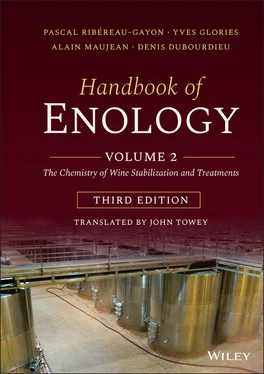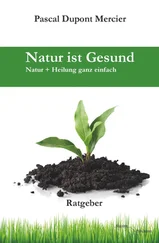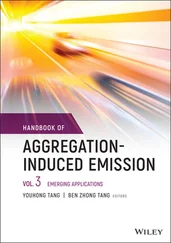Isabelle Masneuf for her investigation of the yeasts' nitrogen supply (Section 3.4.2).
Gilles de Revel for elucidating the chemistry of SO2, particularly details of combination reactions (Section 8.4).
Gilles Masson for the section on rosé wines (Section 14.1).
Cornelis Van Leeuwen for the impact of vineyard water supply on grape ripening (Section 10.4.6).
André Brugirard for the section on French fortified wines—vins doux naturels (Section 14.4.2).
Paulo Barros and João Nicolau de Almeida for their work on Port (Section 14.4.3).
Justo F. Casas Lucas for the section on Sherry (Section 14.5.2).
Alain Maujean for his in‐depth revision of the section on Champagne (Section 14.3).
Bordeaux, May 17, 2004
Professor Pascal Ribéreau‐Gayon
Corresponding Member of the Institut de France Member of the French Academy of Agriculture
PREFACE TO THE FIRST EDITION
Wine has probably inspired more research and publications than any other beverage or food. In fact, through their passion for wine, great scientists have not only contributed to the development of practical enology but have also made discoveries in the general field of science.
A forerunner of modern enology, Louis Pasteur developed simplified contagious infection models for humans and animals based on his observations of wine spoilage. The following quote clearly expresses his theory in his own words: “when profound alterations of beer and wine are observed because these liquids have given refuge to microscopic organisms, introduced invisibly and accidentally into the medium where they then proliferate, how can one not be obsessed by the thought that a similar phenomenon can and must sometimes occur in humans and animals.”
Since the 19th century, our understanding of wine, wine composition, and wine transformations has greatly evolved in function of advances in relevant scientific fields, i.e. chemistry, biochemistry, and microbiology. Each applied development has led to better control of winemaking and aging conditions and of course wine quality. In order to continue this approach, researchers and winemakers must strive to remain up to date with the latest scientific and technical developments in enology.
For a long time, the Bordeaux School of Enology was largely responsible for the communication of progress in enology through the publication of numerous works (Béranger Publications and later Dunod Publications):
Wine Analysis , U. Gayon and J. Laborde (1912); Treatise on Enology , J. Ribéreau‐Gayon (1949); Wine Analysis , J. Ribéreau‐Gayon and E. Peynaud (1947 and 1958); Treatise on Enology (two volumes), J. Ribéreau‐Gayon and E. Peynaud (1960 and 1961); Wine and Winemaking , E. Peynaud (1971 and 1981); Wine Science and Technology (four volumes), J. Ribéreau‐Gayon, E. Peynaud, P. Ribéreau‐Gayon, and P. Sudraud (1975–1982).
For an understanding of current advances in enology, the authors propose this book Handbook of Enology Volume 1: The Microbiology of Wine and Vinifications and the second volume of the Handbook of Enology Volume 2: The Chemistry of Wine: Stabilization and Treatments .
Although written by researchers, the two volumes are not specifically addressed to this group. Young researchers may, however, find these books useful to help situate their research within a particular field of enology. Today, the complexity of modern enology does not permit a sole researcher to explore the entire field.
These volumes are also of use to students and professionals. Theoretical interpretations as well as solutions are presented to resolve the problems encountered most often at wineries. The authors have adapted these solutions to many different situations and winemaking methods. In order to make the best use of the information contained in these works, enologists should have a broad understanding of general scientific knowledge. For example, the understanding and application of molecular biology and genetic engineering have become indispensable in the field of wine microbiology. Similarly, structural and quantitative physiochemical analysis methods such as chromatography, NMR, and mass spectrometry must now be mastered in order to explore wine chemistry.
The goal of these two works was not to create an exhaustive bibliography of each subject. The authors strove to choose only the most relevant and significant publications to their particular field of research. A large number of references to French enological research have been included in these works in order to make this information available to a larger non‐French‐speaking audience.
In addition, the authors have tried to convey a French and more particularly a Bordeaux perspective of enology and the art of winemaking. The objective of this perspective is to maximize the potential quality of grape crops based on the specific natural conditions that constitute their “terroir.” The role of enology is to express the characteristics of the grape specific not only to variety and vineyard practices but also maturation conditions, which are dictated by soil and climate.
It would, however, be an error to think that the world's greatest wines are exclusively a result of tradition, established by exceptional natural conditions, and that only the most ordinary wines, produced in giant processing facilities, can benefit from scientific and technological progress. Certainly, these facilities do benefit the most from high‐performance installations and automation of operations. Yet history has unequivocally shown that the most important enological developments in wine quality (for example, malolactic fermentation) have been discovered in ultra‐premium wines. The corresponding techniques were then applied to less prestigious products.
High‐performance technology is indispensable for the production of great wines, since a lack of control of winemaking parameters can easily compromise their quality, which would be less of a problem with lower quality wines.
The word “vinification” has been used in this work and is part of the technical language of the French tradition of winemaking. Vinification describes the first phase of winemaking. It comprises all technical aspects from grape maturity and harvest to the end of alcoholic and sometimes malolactic fermentation. The second phase of winemaking “wine maturation, stabilization, and treatments” is completed when the wine is bottled. Aging specifically refers to the transformation of bottled wine.
This distinction of two phases is certainly the result of commercial practices. Traditionally, in France, a vine grower farmed the vineyard and transformed grapes into an unfinished wine. The wine merchant transferred the bulk wine to his cellars, finished the wine, and marketed the product, preferentially before bottling. Even though most wines are now bottled at the winery, these long‐standing practices have maintained a distinction between “wine grower enology” and “wine merchant enology.” In countries with a more recent viticultural history, generally English speaking, the vine grower is responsible for winemaking and wine sales. For this reason, the Anglo‐Saxon tradition speaks of winemaking, which covers all operations from harvest reception to bottling.
In these works, the distinction between “vinification” and “stabilization and treatments” has been maintained, since the first phase primarily concerns microbiology and the second, chemistry. In this manner, the individual operations could be linked to their particular sciences. There are of course limits to this approach. Chemical phenomena occur during vinification; the stabilization of wines during storage includes the prevention of microbial contamination.
Читать дальше












